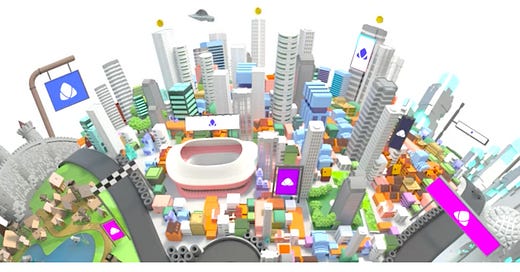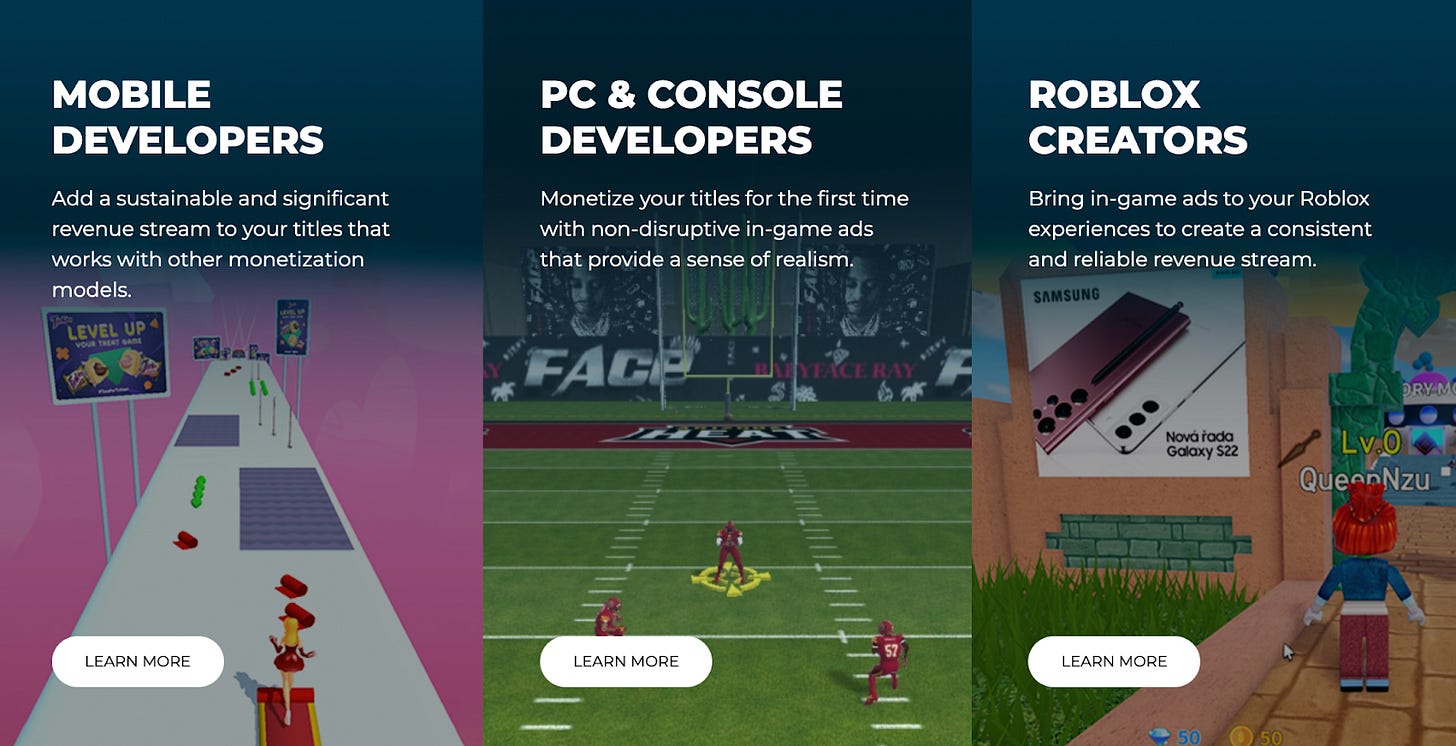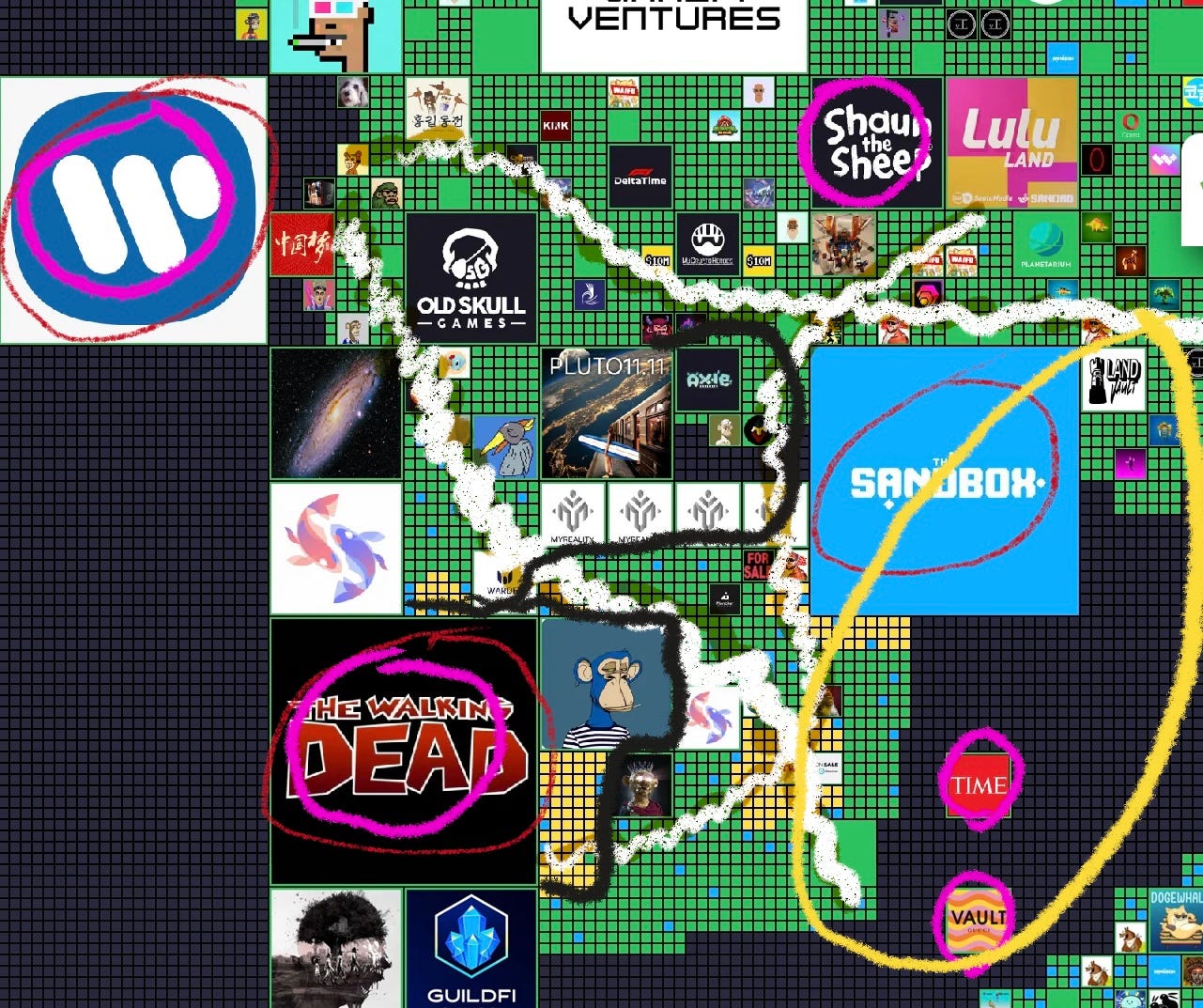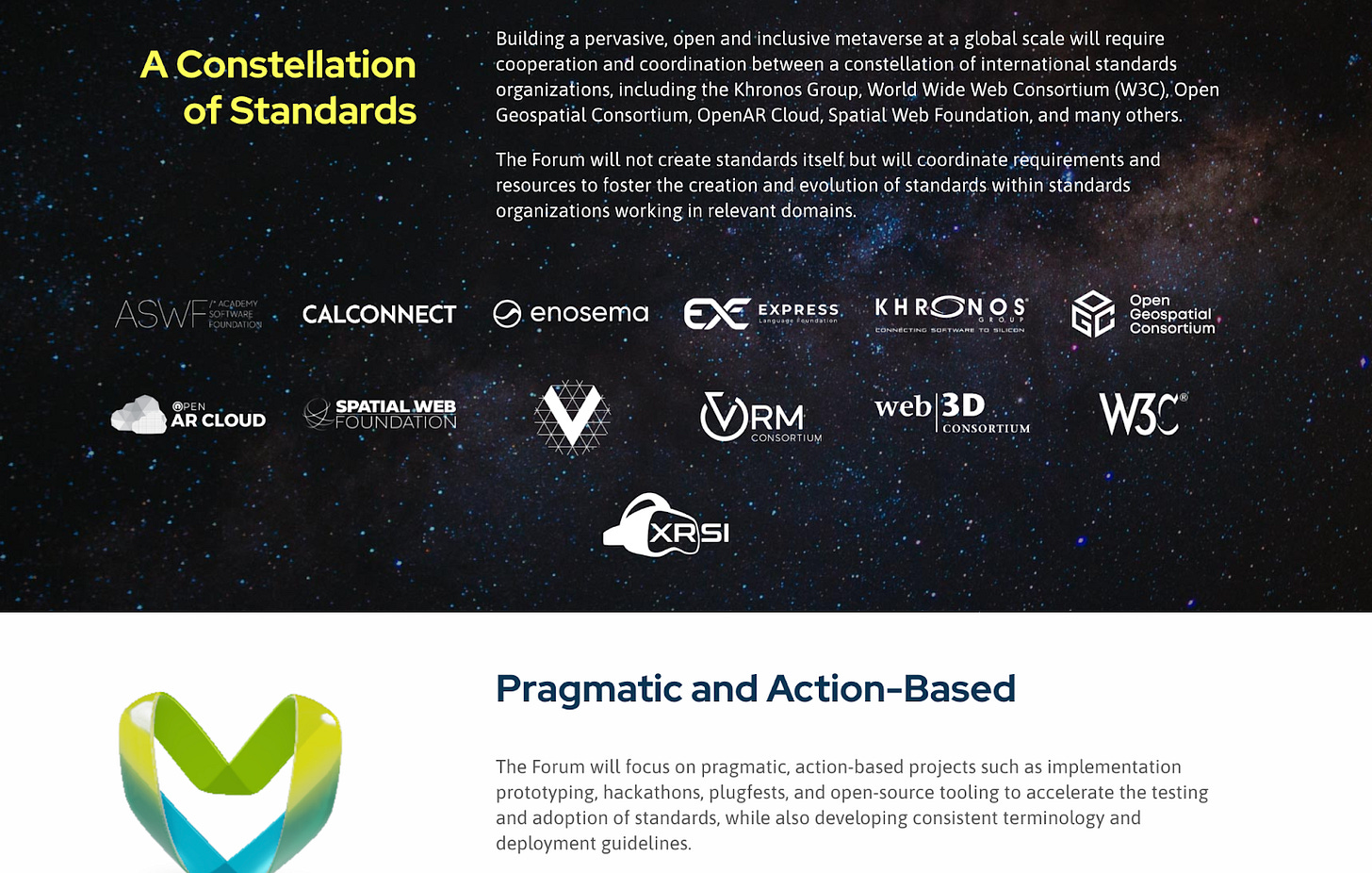The Quiet Metaverse Company Making Millions Part 2
LandVault and the new world of metaverse advertising.
Part 2:
What is Admix (Now LandVault)?
Admix, a digital gaming ad agency, recently acquired and merged with LandVault for an undisclosed amount. The firm will now be called LandVault as one entity. The recent $25 million series B raise from Admix combined with LandVault’s web3 reach and customers have put the now merged entity at a current valuation (at the time of writing) of $300 million (reported by their firm, not a third party). Prior, Admix developed advertising technology that allowed web2 video games to monetize through the equivalent of virtual billboard ads. The merger now classifies the business as a metaverse experience company that also has functional ad monetization tools. Prior to the LandVault purchase, Admix had raised a total of $37 million.
Admix had prior success working with brands but did not have the size or staff to activate on large metaverse initiatives. They actually have a pretty interesting blog post on creating non-intrusive ads through the endless running game genre; such as subway surfers or flappy birds, two popular free-to-play mobile games.
The blog on Admix endless runner advertising here:
https://blog.admixplay.com/exploring-dynamic-ads/
Rather than spending several paragraphs simplifying how in-game ads work, using Unity specifically, here are insightful documents on how the process works. We recommend reading Unity as mobile gaming primarily uses the Unity Engine. Most video game advertising operates on mobile devices, whereas PC and console games have direct payment or more customized microtransactions/IP licensing deals.
How Unity Ads work and how they think about targeting and eCPM:
https://docs.unity.com/ads/MonetizationStrategy.html
Samuel Huber, CEO of Admix (now LandVault), made a statement on Linkedin as to where they saw the value in the acquisition and how they plan to steer the company going forward:
“Last week we announced our biggest news - going all in into web3 and rebranding to LandVault (formerly Admix) 🔥
There are various reasons why we did this. But the main reason was the size of opportunity
Web2 (the current internet) is obviously a huge market
But it’s regulated and saturated. Lots of competition, less room for innovation. A market where it’s more about competing with scale than with innovation.
In the ad tech space (Admix’s market) Google and Facebook are capturing 80% of the ad spend
It’s a red ocean 🔴
The web3 market is obviously a lot smaller, a lot less mature and a lot more risky.
But with no incumbents, less competition and virtually no standards, it also creates a MUCH bigger opportunity to become a category defining company and dominate the space.
It’s a blue ocean 🌊
Let’s be clear, our pivot from web2 to web3 isn’t the safe route. But it’s the route that can lead to the largest opportunity.
The opportunity for us to build the biggest business, but also the opportunity to have the largest impact and affect the most lives for the better 🙏🏼
And as an entrepreneur, it feels like this is an uncapped opportunity I just couldn’t pass on! 🙌🏻”
In this overview, we will share who their competitors are, the state of video game advertising, and emerging themes. It is somewhat accurate that there are no metaverse advertising standards, but that is changing rapidly. We should also touch on what future ad targeting and measurement may look like.
Web2 video game advertising competitors and general background on digital ads.
There are several similar competitors to Admix (now LandVault) where it relates to programmatic or in-game non-intrusive advertising. Some of those competitors include Anzu.io and Bidstack.com, among others. Additionally, there are several much larger advertising competitors that maintain control over general mobile app advertising, but they don’t have the specific focus of in-game non-intrusive advertising.
Anzu: Iimage credit Anzu.io website
Anzu.io is an in-game programmatic advertising company that focuses on delivering top-tier brands and campaigns into the most popular games across mobile and PC. They are currently backed by Bitkraft, Sony Innovation Fund, NBCUniversal, Mediacom, Xbox, Publicis Groupe, and many others. Like Admix (now LandVault), Anzu aims to bring top client real-world advertising into gaming using IAB Compliance practices.
Every recognized gaming advertising company is IAB Compliant. The Interactive Advertising Bureau is an American advertising business organization that develops industry standards, conducts research, and provides legal support for the online advertising industry.
For advertisers, similar to other competitors, Anzu works with DSPs to assist in serving dynamic in-game ads. Of course, these operations must be compliant with local protection laws including GDPR, CCPA, and COPPA. It is worth reading about these protection laws as they will apply to the metaverse.
For clarity, a DSP stands for Demand Side Platform. These are software platforms that allow advertisers to automate the process of buying higher traffic with its ad campaign. Buying higher traffic in simple definition means buying into an audience where your advertising is likely better served. There are many different DSPs, but you can get a much deeper education on DSPs as well as SSPs here: https://www.businessofapps.com/ads/mobile-dsp/
Bidstack: Image credit Bidstack website
Like Admix and Anzu, Bidstack connects advertisers with leading video game titles to engage with the video game-playing market. They have worked with massive companies including Unilever, Penguin Random House, Coca-Cola, and more. They have activated advertising in-game in the genre of racing, sports, open world, and others. Like most video game advertising companies, Bidstack uses ad protection software that helps prevent or report bad ads from reaching a player. Their service allows for in-game dynamic ads, video game start menu ads, and on object advertising such as virtual stadiums or virtual buildings.
RapidFire:
RapidFire, another video game advertising business, writes about the following web2 game advertising verticals.
“Dynamic In-Game Advertising (aka DIGA)
The newest, and by far the most popular type of in-game advertising, DIGA allows media buyers to purchase real-time and geo-targeting capable advertising inside of video games. The adverts appear inside a 3D game environment, on virtual objects such as billboards, posters, and bus stops – all of which are objects that you’d expect to see in a realistic sports or urban environment video game.
Ad networks are able to deliver dynamic in-game ads in real-time using an ad server, in the same way that banner ads are served on websites and blogs. The technology even allows the ads to be placed in games that have already been released; allowing game publishers to earn an additional recurring revenue stream.
One of the benefits of DIGA is the ease of planning and launching a campaign. DIGA allows brands and media buyers to run time-sensitive promotions, on a convenient CPM price model. An advertiser only has to supply standard IAB creatives, and the ads get integrated into blockbuster video game titles on console, PC, and mobile platforms.
Static In-Game Advertising
Often what most people visualize when it comes to in-game advertisements, static in-game advertising takes the form of product placement inside of console, PC, and mobile video games. The advertisements are planned and integrated into a video game during its design and development stage, and therefore allow for much more customized integration. For example, static in-game advertisements are typically integrated into the storyline of a game, or allow players to interact with a brand.
For brands and media buyers looking to reach a global audience, static would be a fantastic channel to pursue because it lacks geo-targeting abilities. It wouldn’t be ideal however for brands looking to promote a time-sensitive campaign, as static in-game ads remain in a video game for its entire life cycle (typically three years).
Advergames
A portmanteau of the words “advertising” and “gaming”, advergames go well beyond just in-game advertising. In short, it’s a custom-built video game with the sole purpose of promoting a brand or product. Advergames can be played on just about any platform, and range from a fully functional 3D game to a simple browser-based mini-game. Typically, an advergame’s storyline, gameplay, and environment will heavily promote the commissioning brand or product.
One of the main benefits of an advergame is the ability for a brand to build a fun and positive connection with consumers. Similarly, with static in-game advertising, advergames are best suited for brands and media buyers looking to drive awareness on a global scale. Costs, development time, and a lack of targeting abilities provide obstacles for most companies pursuing advergames as a channel.”
- RapidFire quote on types of in-game advertising
The future of metaverse advertising
The following concepts around web3 gaming and metaverse advertising are underdeveloped and more thought-provoking than they are prepared to test in practice.
Community Cluster Advertising: similar to market cluster analysis
Cluster analysis is a well-known statistical method that organizes groups or individuals by association. There are 4 common types of clustering such as centroid clustering, density clustering, distribution clustering, and connectivity clustering. This article will not pay deeper attention to in-depth data science, so here are great resources if you’d like to start learning more.
1.
2.https://www.qualtrics.com/experience-management/research/cluster-analysis/
Clustering could be a more effective way to determine metaverse advertising placement because NFTs are underpinned by ERC 1155 or 721 smart contracts. These contracts can be transparently collected and organized through etherscan and other blockchain viewing portals. Sets of NFT collections are owned by an individual or DAO-managed crypto wallets that are easy to track without a paywall. NFT collections are creating sets of communities that can be clustered by similar individuals or DAO-managed wallets.
For metaverse ad space, how would an organization know where to place dynamic ads? Before an organization could acquire or lease metaverse-based land (equivalent to buying web2 traffic), they would first determine age, potential income, potential region, types of NFT assets by wallet, NFT assets by community, social media metrics, art genre, NFT collections by volume, and more. Once they understand the target cluster of NFT communities, the organization will then need to select a metaverse best associated with the cluster of targeted communities. Because metaverse land can be finite, the organization will need to then observe locations that could be related to the cluster, similar to commercial real estate. Here’s an example situation…please see The Sandbox image below.
Image credit: Full Map -https://www.sandbox.game/en/beta-map/?lat=-13&lng=-2&zoom=0
We will be using The Sandbox land as an example because LandVault has built on top of many of the land parcels available. The Sandbox is also the most widely known multi-brand metaverse, which may provide comfort to advertisers so long as the general DAU (daily active users) count is within good measurement with respect to the budget of the campaign or dynamic ads being delivered. DAU measurement is the best measure for the general desire of a game and is the current best measurement we have for metaverses. This scenario could be applied to the “Otherside” metaverse as well.
(the following scenario is made up and only used for explanation of using clusters to target metaverse ads)
Image credit: The Sandbox Map; clusters of community-owned land scenario
Scenario: A new energy drink wants to place a dynamic ad in The Sandbox. They have already completed clustering analysis and determined their audience are likely holders of Doodles, Crypto Punks, Cool Cats, and 10KTF collections. Where should they place their dynamic ads based on the above map? Assumption…dynamic ads can only get placement on the green and yellow tiles. This is due to higher ad prices on gated tiles from larger brands.
In a mature meta ad industry, an algorithm will be able to determine location placement instantly. We will manually make this determination. To make this determination we need to be cognizant of at least 3 types of bias we could foresee arising.
Gravity Well Bias (dark red circles): Large land holdings look attractive to advertisers and other land buyers as it insinuates higher brand value which could equate to more traffic. This is not a good way to establish the value as land acquisition does not tell us about MAU (monthly active users) or visits based on special events.
i95 Bias (white lines between points of interest): The term references the well-known busy and dangerous American highway which is littered with advertisers in the physical world. Traditional advertisers may tackle highways in the metaverse as a way to generate valuable ads. This is incorrect in most cases because the metaverse does not require driving on literal highways or wait times. There is immediate teleportation between clusters of interests where there could be associated local highways. That is at least the current case for The Sandbox and other games like Otherside.
Value Bias (pink circles): Advertisers are just as concerned about content as they are about viewers. On YouTube, many top creators have less direct dynamic ads because the content can be flagged as concerning or potentially damaging to a brand. The same will likely be true for ads in the metaverse. Advertisers will likely place a premium on existing brands with the land. However, advertising should lead to some form of conversion and this may not be likely for some legacy brands. That does not mean legacy brands are bad. Advertisers just need to be aware of how conversion to sales works in the metaverse. Some legacy brands will master the metaverse as a brand, most won't.
Potential position of interest (yellow circle): Bias is not about what should be avoided, but what should be acknowledged to place better advertising. In the scenario presented, we know that this new energy drink is likely best placed in communities such as 10KTF, Coolcats, Doodles, and Crypto Punks.
10KTF: 10KTF is a leading fashion-based NFT. This community is likely to have wallets holding more premium NFTs or 1/1 collector art. It is less commercial in nature and closer to premium art. This brand is affiliated with TIME or Gucci Vault, due to 10KTF having prior work with Gucci.
Coolcats: Coolcats is more gaming and youth brand-focused, so it will likely not establish value near larger points of interest where the brand is older in nature, it may do well closer or next to a children's brand such as “Shaun the Sheep”.
Doodles: Doodles is a high-value brand with an emphasis on music. While the brand itself may have a higher affiliation with WMG, its wallets will likely hold more premium assets and closer collections associated with Gucci or TIME. This affiliation may change with time. Volume, change in ownership, change in brand, or other factors may change the placement. The idea is the ad is trying to target wallet holders in communities, not sponsoring with the Doodles brand itself.
Crypto Punks: As a legacy collection now owned by Yuga Labs, many of the holders are high net worth and valued art collectors that lean closer to high fashion and financial firms. This collection is likely to perform better next to Gucci or TIME. Bored Ape Yacht Club, however, is multifaceted and could perform better near the WMG tile.
5. No man's land (black underline): Meta Advertisers will need to consider land-based areas that may have a great location, but the traffic is nearly eliminated due to land squatters and land brokers who are waiting for land to get acquired by organizations that are more active. Unless the advertiser wants to purchase the land and create an experience (expensive) it would be better to find areas on a metaverse map that do not have as many land squatters and brokers. With that being said, if the land broker is the creator of the metaverse or an established DAO, then there may be opportunities as these may become popular future landmarks.
Full map analysis after product research, community targeting, cluster community analysis, bias acknowledgment, and proximity to metaverse landmarks.
***This is simply an example of a fictional scenario. Future algorithms will be much more accurate and run multiple placement options instantly. Various games with metaverse properties may have their own algorithms. Think of these future metaverse property games like HOAs.***
Composable Asset Advertising
The next generation of static in-game advertising is composable asset advertising. While it is not ready today, we can expect this to be a dominant form of advertising as the metaverse matures across multiple games and ecosystems. It will become a multibillion-dollar industry.
While static in-game ads do well today, they face multiple issues which do not allow for automation of this specific advertising vertical.
We can use world-famous video game designer Hideo Kojima and his game “Death Stranding” as an example.
Image: actual shots from “Death Stranding” a game created by Hideo Kojima
Many fans were confused by this promo in between cutscenes of a high-budget AAA game that was touted as a major video game release. “Death Stranding” story takes place after the world faces extinction-level events. Your character is tasked with helping reconnect America and its wireless communications network. So why would there be multiple Monster Energy drink cans in pristine condition available for consumption? There shouldn’t be.
Read more about the confusion of this static promotion and rights here: https://screenrant.com/death-stranding-directors-cut-removed-monster-energy-drinks/#:~:text=The%20most%20likely%20reason%20for,counterpart%20to%20the%20drinks%20instead.
With composable dynamic ads, Death Stranding would have sold its ad inventory through the action of creating a 3D asset that the main character would drink in a wasteland. The 3D asset would then be wrapped in a brand and aesthetic that would fit the timeline. For example, maybe the main character finds a dusty expired monster energy can on his journey and takes a sip. Now, with composable asset ads, it could be any energy drink brand and the asset would randomize every time a player picks up the game and replays that specific scene. The only differentiation is the 3D wrapping, not the physical 3D model.
Back to The Sandbox, we could see how the previous scenario around an energy drink might work with composable assets ads.
Let’s assume an ad organization has conducted all needed research and clustering analysis. In this additional scenario, they have reviewed value bias and acknowledge that the brands circled are worth targeting. Instead of placing a dynamic ad on in-game billboards and buildings, they decide that the energy drink should have five variations to reflect the five metaverse land communities they are targeting. How will they be able to do this without hiring artists, agencies, advisors, and spending months creating a campaign? How could they get this done in one week or less?
Here’s what the future of composable asset advertising could look like…AI-generated assets backed by file standardization.
Here is a link that will provide an introduction to DALL.E2, a currently available AI system from openai that allows anyone to create new images and memes blended using descriptions in natural language. https://openai.com/dall-e-2/
It’s possible that companies such as openai create an AI system that augments 3D files based on a standardized format. The JPEG of the future may be based on this consortium. Here is the link:
https://metaverse-standards.org/
They currently have over 50 member companies including Epic Games, Adobe, Nvidia, Microsoft, Intel, IKEA, Google, and more.
An AI system, standardized metaverse file format, and a legal tech system that can comb through asset licenses can make composable asset advertising possible. This is currently not available, but if the metaverse is real this is the likely path for a new form of in-game advertising.
The Founders After LandVault (LFG)
Coming full circle on this writeup, we had an opportunity to further interview LandVault founders Boomer and Satsuma on their next venture, which is a slight deviation from servicing Metaverse experiences. Called Life Force Games, the founders are building their own gaming ecosystem that is a blend between video game publisher and metaverse servicing experience.
Here is the website for viewing:
https://lifeforce.games/
Why did you decide to take this path with Life Force Games?
Boomer: “We built LFG because we see a gap in the market (just like we saw the gap in the market and started LandVault) that we think can move the web3 gaming industry forward. We also wanted to make our own games and not just build for others. It's not just lip service, we truly are putting the player first, we want to build for mass adoption in the global gaming market, not targeting just blockchain gamers.”
Can you explain your current goal for Life Force Games?
Boomer: “We are building a suite of games, not AAA but mid-market games that are fun to play but difficult to master. The virtual world will be the glue that ties them all together, not just a place to socialize but where all the economic activity will be as well. Our first game is a tower defense game but with some flare. Won’t go much into it, but it's not just your typical TD game. Our biomes will play a role in how games are played. Hints for game 2? Pew pew.”
How can others make money in the metaverse?
Boomer: “How do others make money? If they are filling a void in a market, the market will seek them out as long as they have decent (not even good) marketing. With LandVault, we did a tweet a day of what we were building and the only text was “gm”. We built for enough communities that eventually we were getting tagged in nearly every metaverse development tweet asking if LandVault built it. We did that by filing a large void in the current metaverse development landscape and showcasing a bit of our work as we went along. If you can do that, the money finds you.”
That wraps up the RE3W newsletter for this week.
If you have an interesting story or would like to reach out, please contact us through our form on:
https://www.re3w.com/
If you like the content please follow us on our socials as well :)

















